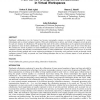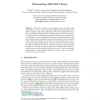181 search results - page 32 / 37 » Reverse Engineering Method Stereotypes |
BMCBI
2008
13 years 7 months ago
2008
Background: Probability based statistical learning methods such as mutual information and Bayesian networks have emerged as a major category of tools for reverse engineering mecha...
ACSC
2006
IEEE
14 years 1 months ago
2006
IEEE
Code obfuscation is a relatively new technique of software protection and it works by deterring reverse engineering attempts by malicious users of software. The objective of obfus...
SIGADA
2005
Springer
14 years 29 days ago
2005
Springer
The En Route Automation Modernization (ERAM) program is a real-time Air Traffic Control (ATC) program being developed by Lockheed Martin Corporation. The ERAM program has high ava...
IRI
2003
IEEE
14 years 23 days ago
2003
IEEE
Distributed collaboration over the Internet has become increasingly common in recent years, supported by various technologies such as virtual workspace systems. Often such collabo...
ESORICS
2008
Springer
13 years 9 months ago
2008
Springer
The mifare Classic is a contactless smart card that is used extensively in access control for office buildings, payment systems for public transport, and other applications. We rev...


